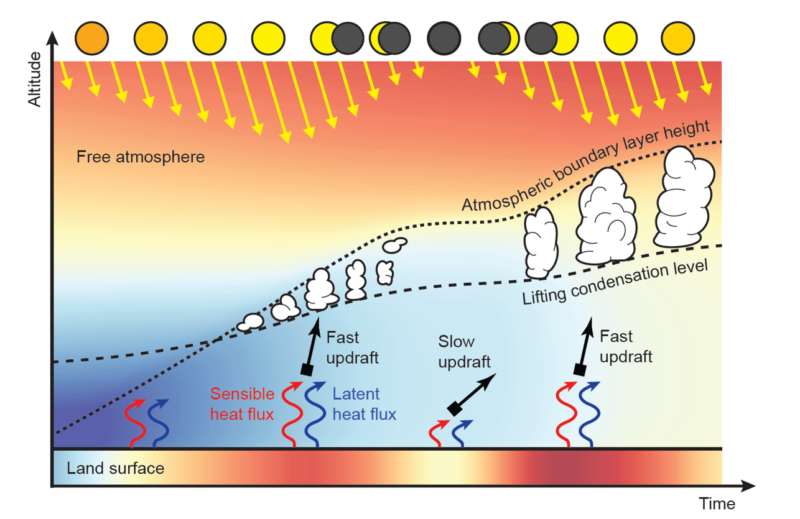Are you worried about clouds during the upcoming April 8, 2024, total solar eclipse? Then this may be some good news for you. According to new research out of the Netherlands, cumulus clouds (those puffy, cotton-like clouds) dissipate quickly during a solar eclipse as the ground cools.
ChatGPT and Kelly Kizer Whitt created a three-point summary for the longer article below:
- Solar eclipses cause rapid dissipation of cumulus clouds, as observed in a study conducted in the Netherlands.
- Researchers used a new method to recover satellite measurements during three solar eclipses.
- The results could have implications for climate engineering using artificial eclipses.

Delft University of Technology in the Netherlands published this original article on February 12, 2024. Edits by EarthSky.
Cumulus clouds disappear during an eclipse
Cumulus clouds over land start to disappear almost instantly during a partial solar eclipse. Until recently, satellite measurements during an eclipse resulted in dark spots in the cloud map. But researchers from Delft University of Technology in the Netherlands (TU Delft) and Royal Netherlands Meteorological Institute (KNMI) were able to recover satellite measurements by using a new method. The results may have implications for proposed climate engineering ideas, because disappearing clouds can partly oppose the cooling effect of artificial solar eclipses.
Although the effects of solar eclipses have been studied for centuries, it was unknown how strong clouds precisely react. Lead author Victor Trees of TU Delft said:
From Earth, you can count the clouds and watch them disappear, but that only provides anecdotal evidence. Even without a solar eclipse, clouds are constantly changing.
The peer-reviewed journal Nature Communications Earth and Environment published the results of the study on February 12, 2024.
Measuring solar eclipses from space
Satellites in geostationary orbit can continuously measure many clouds simultaneously in large areas, including impassable terrain. During a solar eclipse, measurements were not reliable, because the satellite algorithms did not take into account the decrease in sunlight during solar eclipses. This resulted in large dark patches in the cloud maps.
Researchers have now succeeded in restoring satellite measurements during solar eclipses. They did so by accurately calculating the percentage of the sun that is obscured for each location and time on Earth. Trees said:
By far most of the solar eclipse consists of a partial eclipse, where there is still plenty of light outside. In this partial eclipse satellites receive enough reflected sunlight, after correcting for the obscuration, to reliably measure clouds.

Cumulus clouds over land are sensitive to solar eclipses
In the recovered cloud maps from three solar eclipses over Africa, the researchers saw cumulus clouds started to disappear on a large scale starting from just 15% solar obscuration. Once the solar eclipse is over, the cumulus clouds return. On days when there is no solar eclipse, this cloud behavior does not occur.
The disappearance and appearance of clouds has also been simulated successfully with the Dutch cloud model DALES. The model explains that the rising air is almost immediately affected when the partial eclipse starts. Above the sea, the clouds remain unaffected during a solar eclipse, because the seawater does not cool down that fast.

Possible implications for climate engineering
Currently, strategies to artificially cool the Earth are being proposed, for example, placing reflective solar sails into space or aerosols into the stratosphere. These concepts create a subtle and possibly varying solar eclipse. But, according to Trees’ research, clouds begin to disappear on a large scale with only a partial eclipse. Trees said:
This could be a warning for climate engineering. If we eclipse the sun in the future with technological solutions, it may affect the clouds. Fewer clouds could partly oppose the intended effect of climate engineering, because clouds reflect sunlight and thus actually help to cool down the Earth.
In addition, clouds determine local precipitation patterns. The high sensitivity of clouds to solar eclipses calls for more research on the possible effects of artificial shadows.
Bottom line: New research out of the Netherlands says that cumulus clouds disappear quickly during a solar eclipse as air temperatures drop.
Where are clouds least likely to spoil the view during the April 8, 2024, total solar eclipse?
Source: Clouds dissipate quickly during solar eclipses as the land surface cools











